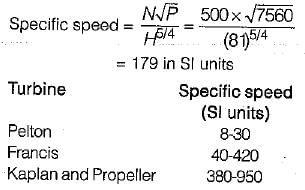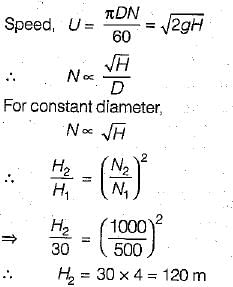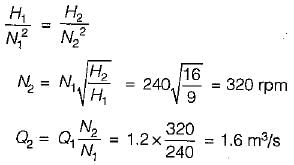Test: Fluid Machines - 3 - Civil Engineering (CE) MCQ
20 Questions MCQ Test - Test: Fluid Machines - 3
A hydraulic turbine has a discharge of 5 m3/sec, when operating under a head of 20 m with a speed of 500 rpm, If it is to operate under a head of 15 m, for the same discharge, the rotational speed in rpm will approximately be
The cavitation and pitting can be prevented by creating which one of the following conditions? .
| 1 Crore+ students have signed up on EduRev. Have you? Download the App |
The overall efficiency of a Pelton turbine is 70%. If the mechanical efficiency is 85%, what is its hydraulic efficiency?
The function of an air vessel in a reciprocating pump is to obtain :
A centrifugal pump gives maximum efficiency when its impeller blades are
The speed factor of a Peiton turbine for maximum efficiency condition is about
The specific speed of a pump of discharge Q, working under a head H at an RPM ‘n' is NSP =
If two pumps identical in all aspects and each capable of delivering a discharge Q against a head H are connected
Cavitatio parameter σ is defined in terms of NPSH (net. positive suction head) and net head H as, σ=
The minimum head a cross the impeller for the delivery to commence is
Rotodyn a micpumps a reclassified as
1. centrifugal pumps
2. screw pumps
3. propeller pumps
Which of these statements are correct?
For lifting oil from very deep oil wells, which of the pumps are used?
The efficiency of a centrifugal pump is expressed in terms of
1. manometer efficiency
2. volumetric efficiency
3. mechanical efficiency
4. overall efficiency
Which of these statements are correct?
A two-dimensional jet strikes a fixed two- dimensional plane at 45° to the normal to the plane, This causes the jet to split into two streams whose discharges are in the ratio
To generate 10,000 HP under a head of 81 m while working at a speed of 500 rpm, the turbine of choice would be
A centrifugal pump running at 500 rpm and at its maximum efficiency is delivering a head of 30 m at a flow rate of 60 liters per minute. If the rpm is changed to 1000, then the head H in metres and flow rate Q in litres per minute at maximum efficiency are estimated to be
Tests were conducted on a francis turbine of 0.8 m diameter under a head of 9m. The turbine running at 240 rpm develops 84.5 kW and the water consumption was 1.2 m3/s. If the some turbine operated under a head of 16 m, the new discharge will be
The overall efficiency of a turbine is dependent on the hydraulic loss, volumetric losses and mechanical losses represent by respective efficiencies. It is related to these by the following relationship























